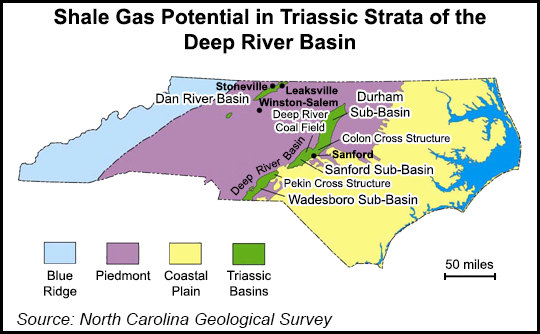With Frack Ban Gone, North Carolina’s Triassic Basins Attracting Interest
A North Carolina official said two oil and gas companies, one of them foreign, are interested in targeting the Triassic basins underlying Lee County and its neighbors for possible shale development as the state has lifted its moratorium on hydraulic fracturing (fracking).

On Tuesday, 120 rules governing oil and gas development, including one lifting the moratorium on fracking, took effect. The rules were created by the state Mining and Energy Commission (MEC), a division of the North Carolina Department of Environment and Natural Resources (DENR), as required by SB 786. The bill, also known as the Energy Modernization Act, was signed into law by Republican Gov. Pat McCrory in June 2014 (see Shale Daily, Dec. 8, 2014; June 5, 2014).
MEC member James Womack told NGI’s Shale Daily that there have already been some early signs of activity by oil and gas companies in the state — specifically, landmen were negotiating leases with landowners, and leases were being pooled into drilling units.
“We’re seeing a little bit of that activity, not a lot,” Womack said Tuesday. “Some of that had already transpired back in 2010 and 2011, so [the oil and gas companies] had already anticipated the need for that kind of activity. In addition, some companies have been checking in with DENR and local chambers of commerce to identify sites at which they could operate.”
Womack said two companies have been “aggressively pursuing and securing sites down here that would allow them to operate in this area, just from a logistical standpoint. They’ve been looking at rail sidings, being able to secure storage sites and being able to physically operate in the area.
“I don’t know of anyone that as of yet has pooled enough land area that would allow them to approach the MEC for a drilling unit. There is some preliminary activity in that area, where there have been some questions and answers lobbed back and forth. But I don’t know of any particular landowners that have been told they’re going to be a part of the first, or an early, drilling unit.
“I sense just from where we are that we’re still perhaps a couple months away from the first drilling unit being formed and the MEC being petitioned for that drilling unit.”
Womack said it was unlikely that an oil and gas company would go through the trouble of applying for a drilling unit just to drill an exploratory well. He added that the MEC would probably process a drilling unit request within 60 days.
“My guess is that if that if they come to the MEC for a drilling unit, they’re going to want the whole enchilada,” Womack said. “They’re going to probably start with an exploratory well, but they’re going to ask for a drilling unit for the express purpose of hydraulic fracturing and horizontal drilling.”
According to Womack, two companies have expressed interest in Lee County, which is in the central part of the state. He declined to identify the companies by name but said one is a group based in North Carolina and the other is a foreign company. He said the former was looking at just Lee County, but the latter was looking at the entire Triassic region — and was not constrained by the current economics from low prices for oil and gas.
“If it was purely an economic driver for [the foreign company], there would be no interest in coming to the Triassic basins and the Sanford sub-basin,” Womack said. “There are plenty of other proven reserves around the country where they would be doing their development. They’re looking at this area because it is of scientific and geological significance to them.”
Womack said low oil and gas prices could also benefit the North Carolina-based company. “It’s kind of counterintuitive,” he said. “There are idle rigs and crews around the country, and the low oil and gas prices have freed up some resources in a few places. That might spring a rig to come to Lee County that otherwise would have been fully engaged in the Marcellus Shale or perhaps down in the Southwest in the Barnett or the Eagle Ford Shale.
“It actually might work to our benefit that oil and gas prices are low.”
North Carolina is home to the Deep River Basin, which the North Carolina Geological Survey said is a 150-mile half-graben that traverses most of the central part of the state in a southwest-to-northeast direction. The basin is divided into three sub-basins — from north to south, the Durham, Sanford and Wadesboro sub-basins — each of which include about 7,000 feet of Triassic strata.
In 2012, the U.S. Geological Survey (USGS) estimated that there was a 95% chance the Deep River Basin held 779 Bcf of natural gas and 35 million bbl of natural gas liquids (NGL), both of which were classified as undiscovered resources (see Shale Daily, June 21, 2012). USGS added that there was a 50% chance the basin held 1.53 Tcf of gas and 75 million bbl of NGLs, and a 5% chance for 2.99 Tcf of gas and 158 million bbl of NGLs. The mean averages of the USGS estimates are 1.66 Tcf of gas and 83 million bbl of NGLs.
© 2024 Natural Gas Intelligence. All rights reserved.
ISSN © 2577-9877 | ISSN © 2158-8023 |
